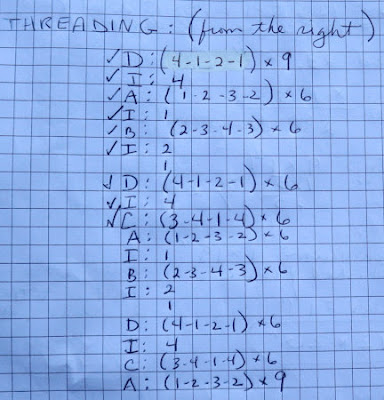I started my calculations by taking a look at the threading and thinking about how it needed to be modified to fit the project width. As I stared at it, it occurred to me that for the rug, I was so focused on following the threading order that I forgot the structure.
By concentrating only on which dot and which heddle came next, I forgot that it was crackle weave. I was thinking more about keeping my place in the draft than in the threading patterns.
The pattern rotates the four crackle threading blocks in a particular order. For one motif, it is:
Block A: 1-2-3-2
Block B: 2-3-4-3Block D: 4-1-2-1Block C: 3-4-1-4
Rather than trying to keep track of where I am on the draft, it's actually easier to keep remember a 4-number sequence, such as 1-2-3-2 while I'm threading heddles. I'm even clever enough to remember which shaft the sequence starts on, so that I can count them at the same time. Block A, for example, (1)-2-3-2, (2)-2-3-2, (3)-2-3-2, etc.
With that in mind, I thought it might be easier to make and follow a profile draft. Profile drafts are shorthand drafts. Each square or line on the grid represents a particular threading sequence. The number of squares in the line represents the number of repeats. The columns represent which block is being threaded. Hence, the above threading draft looks like this:
That doesn't include the incidentals, however. Incidentals are extra threads added to transition from one block to another as needed. To visualize that, I added the incidentals in red.
I have no idea if this is the proper way to make a crackle profile; if incidentals are even notated in crackle profile drafts. The incidentals simply repeat the first thread in the block, so I'm probably supposed to have their use memorized. I'm not there yet. I'm just hoping this will be easier to follow. The exercise definitely made it easier to visualize.
I don't have a printer, so I didn't actually get to test this out at the loom. Instead, I wrote it out in my weaving notebook thus:
So far so good and threading is going quickly.
In contemplating thinking patterns, I realized it's about mentally visualizing information. I'm sure there are labels for things like this. I idly wonder if it's connected to personality types or some such. That might be interesting to read about, but on a practical level, the important thing is that I figured out what works best for me.
© Sept 2024 by Leigh at Leigh's Fiber Journal
Related posts






4 comments:
Leigh, I can imagine that the keeping track of the threads for patterns would be incredibly difficult (maybe more so for me, as I struggle with that kind of thing). Having some kind of mental pattern of A, B, C,D, or such really helps me with even the most basic of tasks.
TB, I have to wonder how other weavers do it, how they keep track. I used to use a paper clip to track my progress, but like you say, a mental pattern really makes it easier.
Leigh, I'm not familiar with Cracke, so I could be very wrong, but reading your words, and looking at your profile draft with incidentals, my understanding is:
A: 1-2-3-2 with an extra 1 at the end;
B: 2-3-4-3 with an extra 2 at the end;
D: 4-1-2-1 with an extra 4 at the end; and
C: 3-4-1-4 with an extra 3 at the end???
Apologies if I misunderstood.
Regarding standards and rules, whatever works for you best is best for you, so congrats on your own notation.
Meg, I just started re-reading Susan Wilson's Weave Classic Crackle & More, so hopefully I'm finally "getting" it about incidentals.
1. use an incidental at the end of each block (repeating the first thread in the block, as you point out.)
2. use a second incidental to represent a skipped block.
So between the 2nd and 3rd block (B and D), I'm thinking the incidentals ought to be 2, 3, (because the skipped block starts on 3) instead of 2, 1. EXCEPT, 2, 1 is what the draft says. It works out because it's still treadled alternating odd and even shafts.
Also, after the last block (between C and A) the incidentals ought to be 3, 4 (because D is skipped). None are included in the draft, so I didn't think to add them. But the pattern is going from shaft 4 to 1, so it seems to be working out.
Funny, but the first time I read that section of her book I wasn't getting it. With a little experience to reflect back on, it makes more sense.
Weaving is coming along and I hope to post some pictures and details soon.
Post a Comment